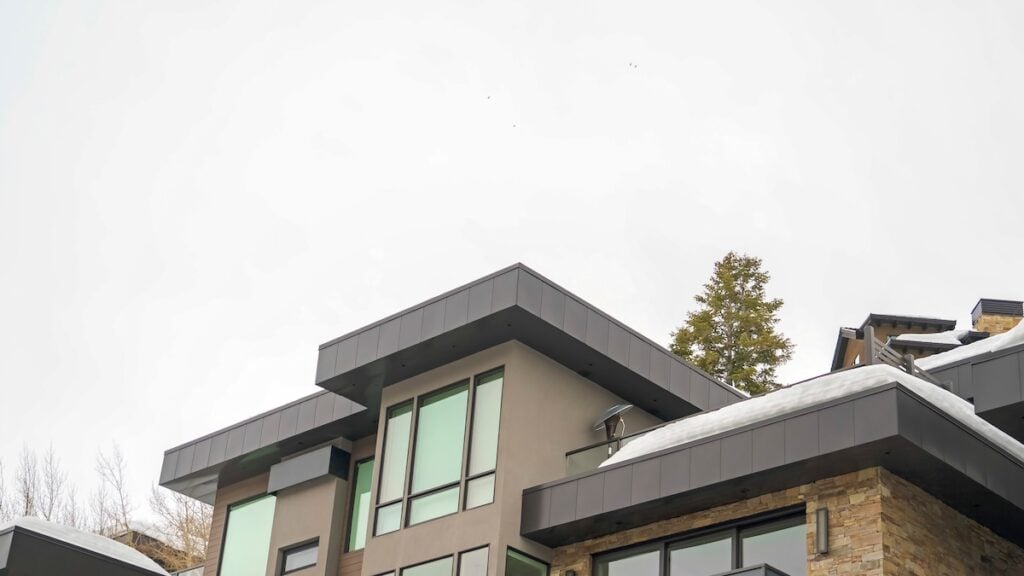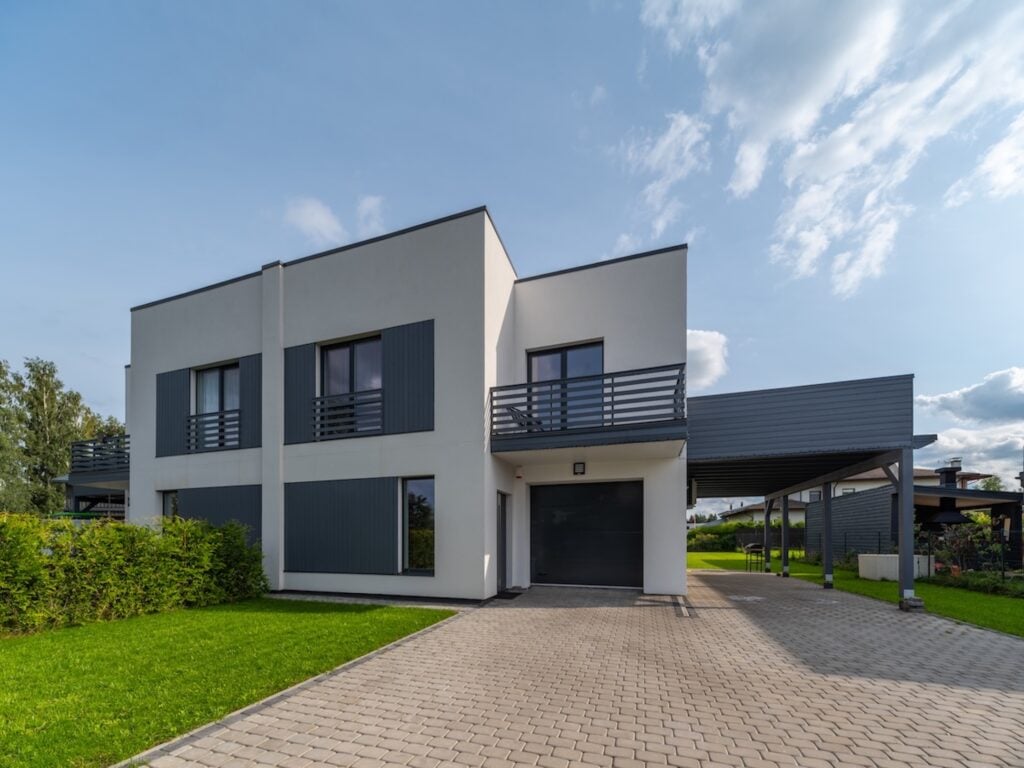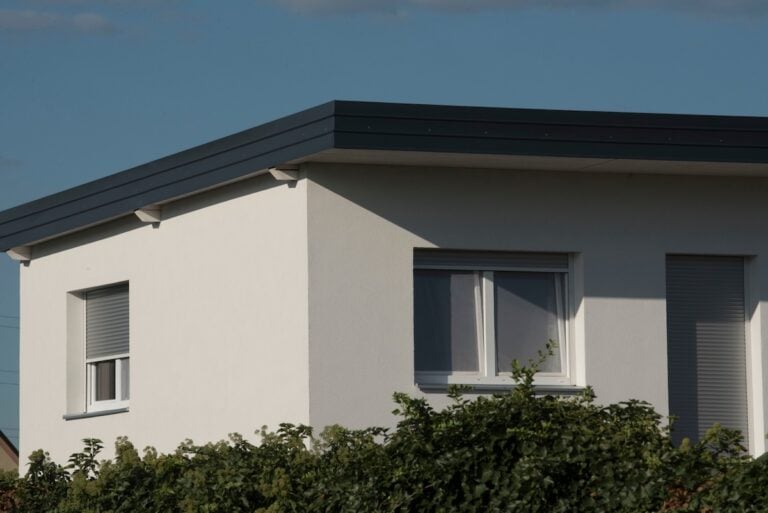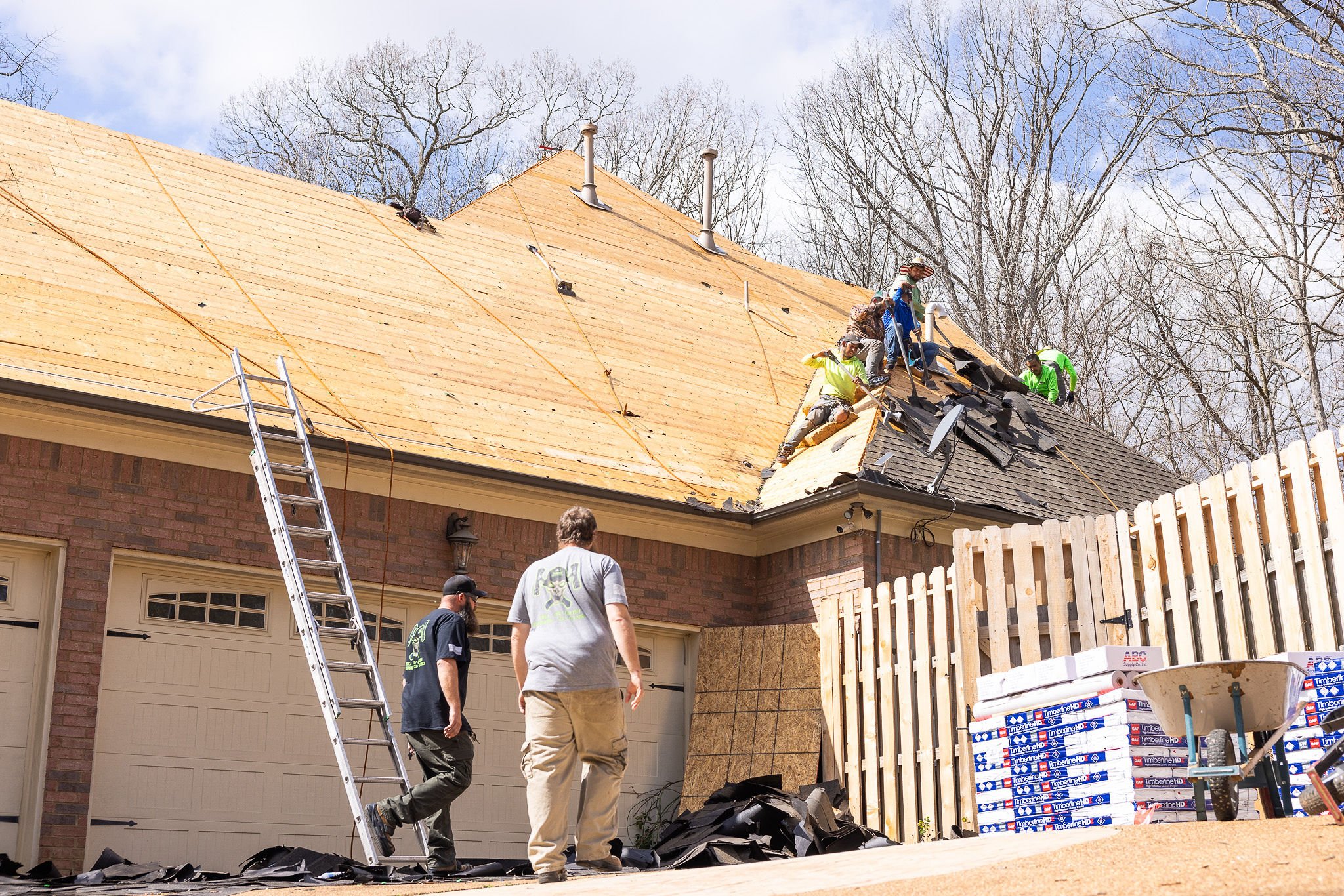When considering roofing options for your property, flat roofs offer unique advantages that make them an increasingly popular choice for both residential and commercial buildings. While the name suggests a completely level surface, flat roofs actually have a slight slope to ensure proper water drainage.
Understanding the ins and outs of flat roofing systems can help you make an informed decision for your property.
This comprehensive guide will cover:
- Why flat roofs are important for modern construction
- Essential knowledge about flat roof systems
- Key maintenance practices to extend roof life
- Common challenges and solutions
🏢 Why Flat Roofs Are Important

Flat roofing systems have become essential in modern construction due to their practical benefits and cost-effectiveness. Understanding these advantages helps property owners make smart roofing decisions.
Flat roofs offer several compelling benefits:
- Cost-effective installation: Flat roofs generally require fewer materials and less labor, making them more economical to install than pitched roofs.
- Additional usable space: The flat surface can be utilized for various purposes, such as rooftop gardens, placement of HVAC equipment, or recreational areas.
- Easy maintenance access: Their flat design makes it safer and simpler for technicians to access and perform inspections or repairs.
- Energy efficiency: Flat roofs can more easily accommodate insulation and reflective materials, which helps improve a building’s energy performance.
- Modern aesthetic appeal: They contribute to a clean, contemporary look, aligning well with modern architectural designs.
👉 7 Essential Things You Need to Know About Flat Roofs

Understanding these fundamental aspects of flat roof systems will help you make informed decisions about installation, maintenance, and repairs.
1. Types of Flat Roofing Materials
Different materials offer varying levels of durability, cost, and performance characteristics. Choosing the right material is crucial for the longevity and efficiency of your flat roof system.
- EPDM rubber: Ethylene Propylene Diene Monomer is a single-ply synthetic rubber membrane known for its flexibility, durability, and resistance to UV radiation and weathering. It’s a popular choice for its long lifespan and ease of installation, often lasting 20-30 years with proper maintenance.
- TPO (Thermoplastic Polyolefin): TPO is a single-ply membrane that is energy-efficient, particularly the white versions, which reflect sunlight and reduce cooling costs. It’s highly resistant to punctures, tears, and chemical exposure, offering excellent UV resistance. TPO roofs typically last 15-20 years.
- PVC (Polyvinyl Chloride): Another single-ply membrane, PVC is extremely durable, fire-resistant, and highly resistant to chemicals and moisture. Its heat-welded seams create a strong, watertight bond, making it an excellent choice for roofs exposed to harsh conditions. PVC roofs can last 20-30 years or more.
- Modified Bitumen: This is an asphalt-based membrane modified with polymers to improve its flexibility and resistance to temperature fluctuations. It’s often installed in layers (two or three-ply systems) for added strength and waterproofing, and can be applied using torch-down, hot asphalt, or self-adhesive methods. Modified Bitumen roofs typically have a lifespan of 10-20 years.
- Built-Up Roofing (BUR): Also known as “tar and gravel” roofs, BUR systems consist of multiple layers of asphalt-saturated felts alternated with layers of hot asphalt, topped with a layer of gravel or other surfacing material. They are known for their durability and fire resistance, offering a lifespan of 20-30 years.
2. Drainage Systems Are Critical
Proper water management is paramount for flat roofs to prevent water accumulation, which can lead to leaks, structural damage, and premature aging of the roofing materials.
- Built-in slope: Even what appear to be “flat” roofs are designed with a minimum slope of 1/4 inch per foot (or approximately 2%) to ensure positive drainage. This slight incline directs water towards drainage points, preventing ponding. Without adequate slope, water can sit on the roof surface, stressing materials and potentially finding its way into the building.
- Drain placement: Strategic positioning of drains, scuppers, and gutters is essential. Drains should be located at the lowest points of the roof, often in multiple locations, to efficiently remove water. Scuppers (openings in the parapet wall) are used to direct water off the roof edge into downspouts or gutters, while internal drains lead water through the building’s interior. Proper sizing and clear pathways for these systems are vital.
- Tapered insulation: Tapered insulation boards are often installed beneath the roofing membrane to create the necessary slope for drainage, especially on roofs that initially lack sufficient pitch. This system guides water effectively to drainage outlets.
- Overflow prevention: Including overflow drains or scuppers is a critical safety measure. These secondary drainage points are set slightly higher than the primary drains, ensuring that if the main system becomes clogged, water can still escape, preventing catastrophic roof collapses due to excessive water weight.
3. Insulation Requirements
Adequate insulation is not only crucial for improving a building’s energy efficiency but also plays a significant role in preventing moisture problems and maintaining the structural integrity of the roof system.
- R-value considerations: The R-value measures a material’s thermal resistance. Climate zone, local building codes, and desired energy performance determine the minimum required R-value for flat roof insulation. Higher R-values provide better thermal performance, reducing heating and cooling costs and creating a more comfortable interior environment.
- Vapor barrier installation: A vapor barrier (or vapor retarder) is a critical component installed on the warm side of the insulation layer (typically under the insulation in cold climates) to prevent moisture-laden air from condensing within the roof assembly. Condensation can lead to mold growth, degradation of insulation, and damage to the roof deck, compromising the entire system’s performance and lifespan.
- Types of insulation: Common types of flat roof insulation include polyisocyanurate (polyiso), expanded polystyrene (EPS), and extruded polystyrene (XPS). Each offers different R-values, compressive strengths, and moisture resistance properties. Polyiso is widely used for its high R-value per inch, while EPS and XPS are known for their moisture resistance and versatility.
- Attachment methods: Insulation can be mechanically fastened, adhered with adhesive, or laid loose in conjunction with ballast (like gravel). The chosen method depends on the specific roofing system, local wind uplift requirements, and the structural capacity of the building.
4. Professional Installation Is Essential
The long-term performance, durability, and warranty coverage of a flat roof system are overwhelmingly dependent on the quality of its installation. Professional expertise ensures that complex materials and systems are applied correctly.
- Certified contractors: Working with highly experienced and certified contractors, especially those affiliated with reputable manufacturers like GAF Master Elite contractors, is paramount. These certifications indicate that the installers have undergone rigorous training, adhere to strict installation standards, and are qualified to offer enhanced manufacturer warranties.
- Quality control measures: Proper installation involves meticulous attention to detail at every stage. This includes thorough substrate preparation, correct application of primers and adhesives, precise cutting and fitting of membranes, and secure, watertight seaming (e.g., heat-welding for TPO/PVC, proper lap adherence for EPDM). Inadequate seaming or adhesion is a leading cause of leaks and premature roof failure.
- Adherence to specifications: Professional installers strictly follow manufacturer specifications and local building codes. Deviating from these guidelines can void warranties, lead to performance issues, and potentially compromise safety.
- Project management: A professional contractor will also provide effective project management, including proper staging of materials, adherence to safety protocols, efficient scheduling, and clear communication throughout the project duration, minimizing disruption and ensuring a smooth installation process.
5. Regular Inspections Prevent Major Issues
Proactive maintenance, especially regular inspections, is the most cost-effective strategy for extending the life of a flat roof and avoiding expensive, emergency repairs.
- Seasonal checkups: Conducting inspections at least twice a year, ideally in the spring and fall, allows for the identification of damage caused by winter weather (freeze-thaw cycles, snow load) or summer heat (UV degradation, thermal expansion). Look for visible cracks, punctures, blisters, standing water, and clogged drains.
- Professional assessment: While property owners can perform visual checks, a professional roofing contractor brings trained eyes and specialized knowledge. They can spot subtle signs of wear, degradation, or potential entry points for water that might be missed by an untrained observer. Professionals can also assess the integrity of seams, flashings, and penetrations – common areas for issues.
- Debris removal: Accumulation of leaves, branches, dirt, and other debris can trap moisture, promote vegetation growth, and block drainage systems, leading to accelerated deterioration. Regular removal of such debris is a simple yet effective maintenance step.
- Documentation: Keeping detailed records of inspection findings, maintenance activities, and any repairs performed helps track the roof’s condition over time, informs future maintenance planning, and can be valuable for warranty claims or insurance purposes.
6. Weather Resistance Capabilities
Modern flat roof systems are engineered to withstand a variety of harsh weather conditions. However, their ability to perform effectively hinges on proper selection of materials, correct installation, and ongoing maintenance.
- Wind uplift resistance: Flat roofs are particularly susceptible to wind uplift forces. Proper attachment methods, including mechanical fasteners, adhesives, and ballast, are crucial to ensure the roofing membrane remains securely in place during high winds and severe storms. Edge detailing and perimeter fastening are critical areas for wind resistance.
- Thermal expansion management: Roofing materials expand when heated and contract when cooled. Quality materials and proper installation techniques, such as allowing for expansion and contraction at seams and terminations, are essential to prevent cracking, splitting, and stress on the membrane due to extreme temperature fluctuations. Light-colored membranes like white TPO and PVC help by reflecting sunlight and reducing surface temperature.
- UV degradation: Prolonged exposure to ultraviolet (UV) radiation from the sun can degrade roofing materials over time, leading to brittleness, cracking, and loss of elasticity. Many modern flat roof membranes are formulated with UV stabilizers, and reflective surfaces are used to mitigate this effect, extending the material’s lifespan.
- Hail and impact resistance: Some flat roof membranes, particularly thicker EPDM and reinforced TPO/PVC, offer good resistance to hail and other impacts. In areas prone to severe weather, selecting materials with higher impact resistance ratings can significantly enhance the roof’s durability.
7. Expected Lifespan and Warranties
Understanding the expected lifespan of different flat roofing materials and the details of their warranties is crucial for budgeting, long-term planning, and ensuring peace of mind.
- Material warranties: Manufacturer warranties typically cover defects in the roofing material itself. These can range significantly, often from 10 to 30 years, depending on the specific product, thickness, and manufacturer. It’s important to understand what components are covered (e.g., membrane only, or full system), the conditions for validity (e.g., proper installation by certified contractor), and the extent of coverage (e.g., full replacement, pro-rated).
- Workmanship warranties: In addition to material warranties, a reputable roofing contractor should provide a separate workmanship warranty, covering the quality of their installation. This warranty typically lasts for a shorter period, often 1 to 10 years, and protects against leaks or failures directly caused by installation errors.
- Maintenance requirements: Most warranties stipulate that the roof must be properly maintained to remain valid. Neglecting regular inspections, debris removal, and necessary repairs can void a warranty. Understanding and adhering to these maintenance requirements is vital for ensuring coverage.
- Actual service life: While warranties provide a guarantee for a specific period, the actual service life of a flat roof can often exceed its warranty period, especially with diligent maintenance and quality installation. Factors such as climate, building use, and the severity of weather events also influence how long a roof truly lasts. Budgeting for eventual replacement based on the expected lifespan (rather than just the warranty) is a prudent financial strategy.
🛠️ Flat Roof Maintenance Best Practices

Proper maintenance ensures your flat roof investment provides maximum value and longevity. Regular attention to key areas prevents minor issues from becoming major problems.
- Drainage Maintenance: Regularly clear drains, gutters, and scuppers of leaves, dirt, and debris. Blocked drainage can cause water to pool, leading to leaks, structural damage, and costly repairs.
- Surface Inspection: Walk your roof at least once each season to spot punctures, tears, or loose membranes. Catching these issues early prevents them from turning into expensive problems.
- Sealant Checks: Inspect all roof edges, seams, and areas around penetrations like vents and skylights. These spots are highly prone to water infiltration and need proper sealing to protect the roof.
- Professional Assessments: Hire a licensed roofing contractor annually to conduct a thorough inspection. Their expertise helps identify hidden damage or potential problems that aren’t visible to the untrained eye.
- Preventive Repairs: Fix minor issues, like small membrane tears, right away to avoid escalating damage. Prompt repairs save money and extend the life of your roof by preventing water exposure.
👨🔧 Get Expert Flat Roof Solutions Today
Flat roofing systems offer excellent value when properly designed, installed, and maintained. The key to success lies in working with experienced professionals who understand the unique requirements of flat roof construction and maintenance.
Your roof protects everything beneath it, making professional expertise essential for long-term performance and peace of mind. Don’t trust your property’s protection to inexperienced contractors or DIY solutions.
Ready to explore flat roofing options for your property? Contact Summit Roofing & Restoration today for a free inspection and consultation. Our certified professionals will assess your needs and provide expert recommendations tailored to your specific situation.


